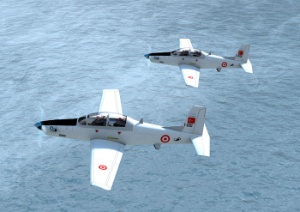Jul 20 2010
Defense Holdings, Inc.®, (DHi®), The Idea Company®, has concluded a distributorship agreement with Hartzell Propeller Inc. of Piqua, OH for use of DHi’s AfterGlo® Brand Photoluminescent Aviation Safety Paint on Hartzell’s line of aircraft propellers.
 Hartzell's Propellers For The Turkish Air Force's KT-1 Trainers Have Blades Tipped With DHi's PL Paint.
Hartzell's Propellers For The Turkish Air Force's KT-1 Trainers Have Blades Tipped With DHi's PL Paint.
AfterGlo® paint is used to for safety markings to improve the visibility of aircraft propellers in low-light situations. Sherwin-Williams Aerospace Coatings formulates the paint for DHi.
Under the agreement, Hartzell becomes the exclusive world-wide distributor for application of AfterGlo® Brand PL Safety Paint on constant-speed aircraft propellers installed on engines from 150 shp up to 1800 shp. Hartzell will offer DHi’s AfterGlo® Brand Photoluminescent (PL) Safety Paint as an option on new Hartzell propellers from its factory. In addition Hartzell will obtain certification for use of Hartzell Propeller Inc. part number A-6741-233-1 PL Paint Kit on existing Hartzell propellers through its network of propeller repair stations and military maintenance depots. The introductory list price of the Hartzell PL Paint kit is $1369 and will cover approximately 20 blade tips. Hartzell also becomes a non-exclusive world-wide distributor for DHi’s AfterGlo® Brand Photoluminescent (PL) Safety Paint under the agreement on a not-to-interfere basis with DHi’s current markets.
For non-Hartzell products, DHi will continue to offer direct sales of AfterGlo® Brand PL Safety Paint for use on fixed propellers, constant-speed aircraft propeller installed on engines less than 150 shp or more than 1800 shp, and on propellers used for non-aircraft applications (e.g. hovercraft, rotorcraft, etc.). Further, DHi will continue to provide its AfterGlo® Brand PL Safety Paint kits purchased using DHi’s part numbers, U.S. Government assigned National Stock Numbers, and through direct sales to the General Services Administration (GSA) or any other Governmental agency or activity. The agreement with Hartzell does not serve to interfere in any way with Company’s pre-existing Distributor Agreement with Alliance Coatings, Inc., or with the sale of AfterGlo® Brand PL Safety Paint through GSA Schedules.
DHi’s AfterGlo® Brand PL Safety Paint has been successfully used on Hartzell’s 4-blade lightweight turbine propellers retrofitted on approximately 100 Korea Aerospace Industries KT-1 trainer aircraft operated by the Republic of Korea Air Force and now being delivered on 40 new build KT-1T aircraft for the Turkish Air Force.
Rich Martin, DHi’s President and CEO, states, “Defense Holdings, Inc. is excited to be working with Hartzell Propeller to gain type approval for use of our AfterGlo® Brand Photoluminescent Safety Paint on other types of Hartzell propellers. Hartzell propellers are used on a wide range of piston and turboprop powered aircraft, including many of the world’s trainer aircraft. In addition to being used on the Korea Aerospace KT-1, Hartzell propellers are used on a variety of trainer aircraft from Embraer, Hawker Beechcraft, Pilatus and many others. Where better to be able to offer enhanced safety than in the world’s flight training commands?”
Mike Disbrow, Hartzell’s Senior Vice President of Marketing and Customer Services, added, “We collaborated with DHi to develop and test the application of their PL paint system on our propellers so that our customers could gain access to technology that will greatly improve the safety of their aircraft operations and airport personnel who work at night and under low light conditions. As a company focused on the safety of our products, we’re delighted to be able to offer this impressive technology exclusively to our customers.”
The AfterGlo® Brand Photoluminescent Paint System (PLPS) was substantially developed under a US Navy Small Business Innovative Research (SBIR) Initiative for use on US Navy propeller-driven aircraft flying from aircraft carriers The Navy has converted all its E-2/C-2 aircraft to this propeller paint scheme in 2008 following nearly five years of successful research, development, and testing. The aerospace grade PL paint is applied to the blades and blade tips of helicopter main and tail rotors and aircraft propeller blades to aid personnel in avoiding injury or death from coming into contact with them in low light situations. The initial application of this paint was on the Navy’s E-2C carrier-based aircraft to help save the lives of men and women who must work at night in the vicinity of rapidly spinning propeller blades on aircraft carrier flight decks where inadvertent contact can have deadly results. The PL paint is now in use on nearly a hundred U.S. Navy aircraft as well as the aircraft of a number of foreign navies. In addition to the work with the US Navy and Hartzell, testing of the paint is now underway on helicopter main and tail rotors and DHi is in discussions with a number of helicopter OEMs as well as a number of fixed-wing aircraft builders regarding adoption of the paint for their aircraft.
Potentially distracted by noisy, high tempo flight operations, ground and flight personnel are inadvertently struck each year by propeller blades and helicopter main and tail rotors with inevitably tragic consequences. DHi’s solution combines a revolutionary, long-lasting, ultra-bright, non-radioactive PL material with a high-quality aerospace coating and offers the option of adding an equally effective retro-reflective material to dramatically improve propeller blade visibility under all lighting conditions. The application maximizes visibility, material adhesion, durability, wear resistance and ease of installation without compromising propeller/rotor aerodynamic performance or aircraft detection. Materials using these photoluminescent phosphors are visible through Night Vision Goggles (NVGs), but since the wavelength of the emitted light is outside of the range of these NVGs, use of the paint does not cause the NVGs to “bloom”, interfere with aircrew visibility, or make the aircraft more vulnerable to hostile visual detection.